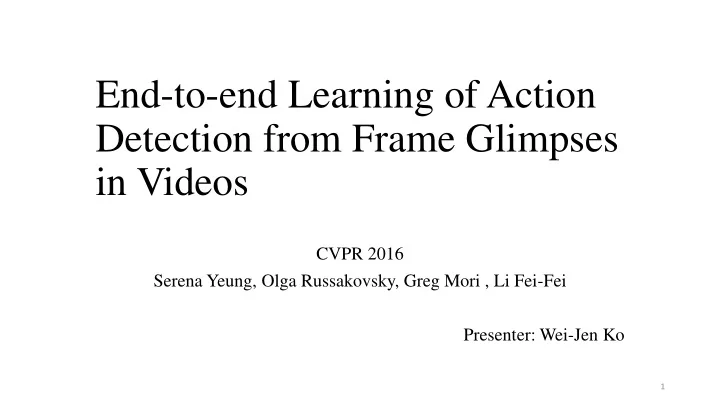

End-to-end Learning of Action Detection from Frame Glimpses in Videos CVPR 2016 Serena Yeung, Olga Russakovsky, Greg Mori , Li Fei-Fei Presenter: Wei-Jen Ko 1
Action detection • Predict which and when action occurs in the video. 2
Related Work Motion features: Dense Trajectories Apearance features: CNN+SIFT+ COLOR Audio features: MFCC+ASR Classified by SVM over exhaustive segments with varying scale and temporal position. D. Oneata, J. Verbeek, and C. Schmid. The lear submission at thumos 2014. L. Wang, Y. Qiao, and X. Tang. Action recognition and detection by combining motion and appearance features J. Yuan, Y. Pei, B. Ni, P. Moulin, and A. Kassim. Adsc submission at thumos challenge 2015 3
Related Work Dynamic feature prioritization Predictive corrective networks Y-C. Su and K. Grauman. Leaving Some Stones Unturned: Dynamic A. Dave, O. Russakovsky, D. Ramanan. Predictive-Corrective Networks Feature Prioritization for Activity Detection in Streaming Video , ECCV for Action Detection, CVPR 2017. 2016. 4
Proposed method • Recurrent neural network-based end-to-end model • Decides which frame to observe next and when to emit a prediction. 5
Observation Network Video frame V ln Image fearure VGG On FC Frame location ln
Recurrent Network s n : start location of the action e n : end location of the action l n+ 1 : location of the video frame to observe next c n : confidence level of the prediction P n : prediction indicator S n, e n, l n+ 1 normalized to [0,1] 7
8
Loss function L cls (d n ): Cross-entropy loss on confidence Cn L loc (d n , g m ) : L2- regression loss minimizing the distance 9
p n and l n+1 trained by REINFORCE Reward function negative reward if did not emit predictions for videos containg instances 10
THUMOS’14 Results 11
If observed frames are not be determined dynamically, it does not provide sufficient resolution to localize action boundaries. 12
ActivityNet Results 13
Strengths: • First End-to-end training approach • Select important frames to observe, no exhaustive searching • Better results 14
15
Recommend
More recommend